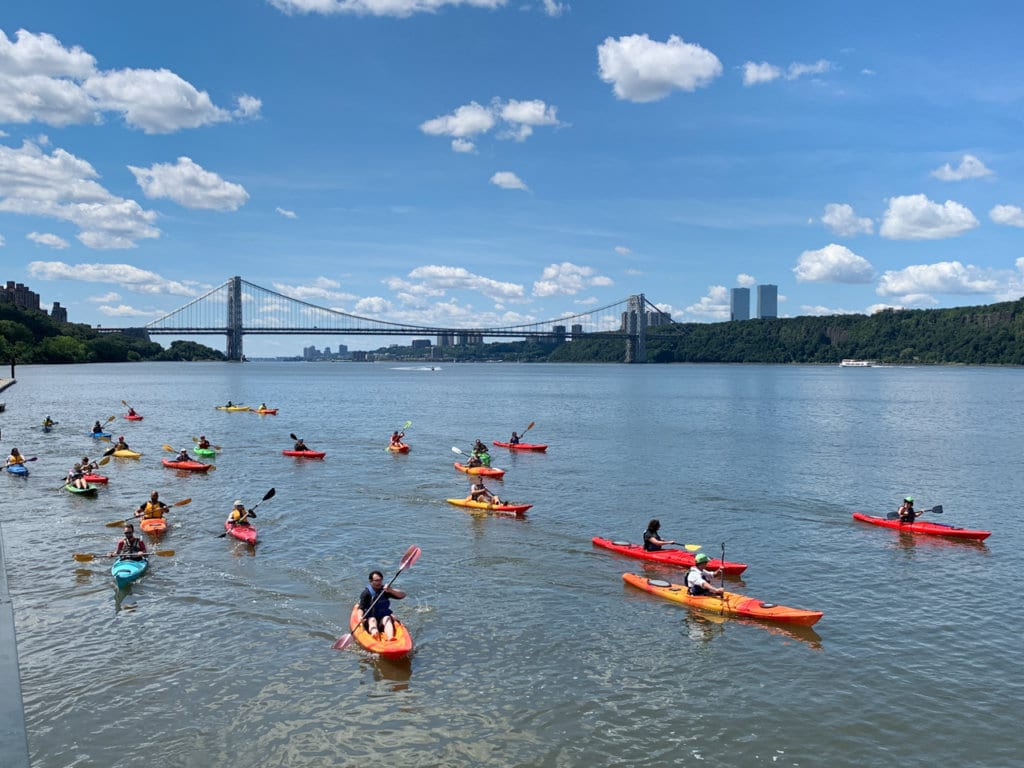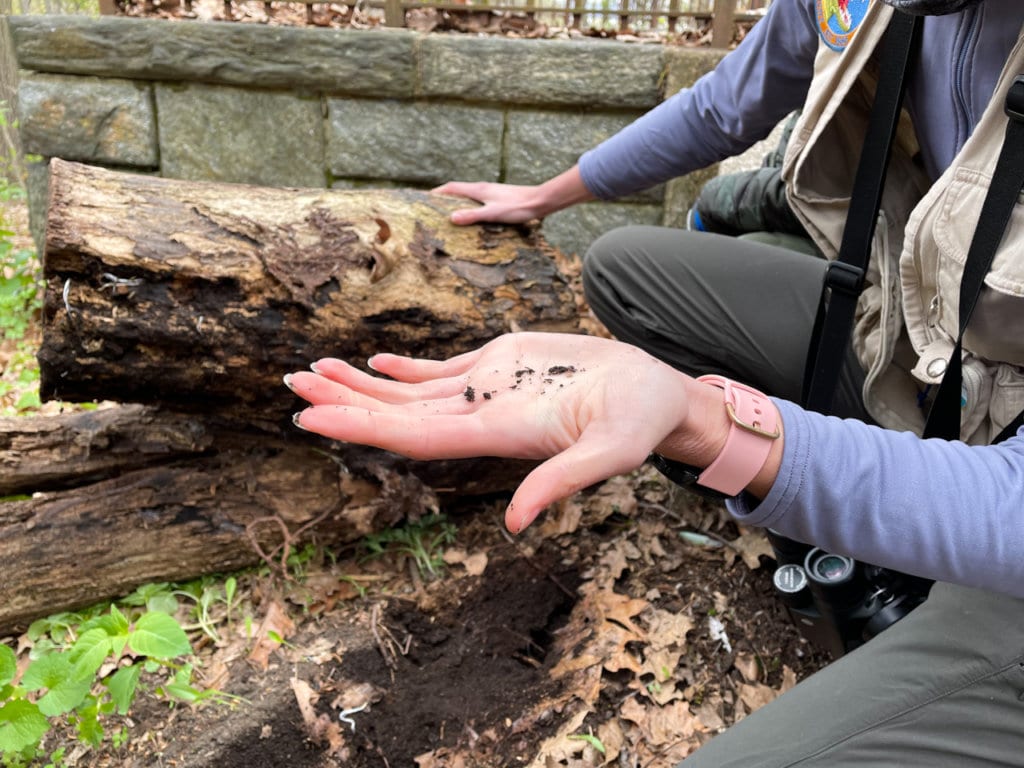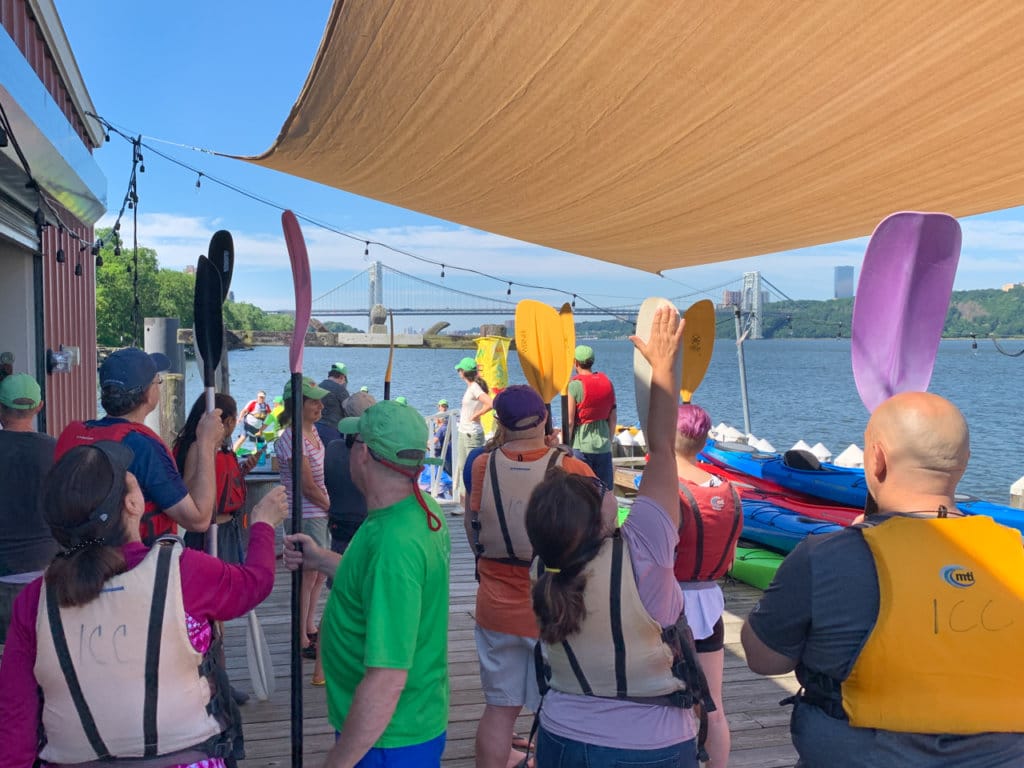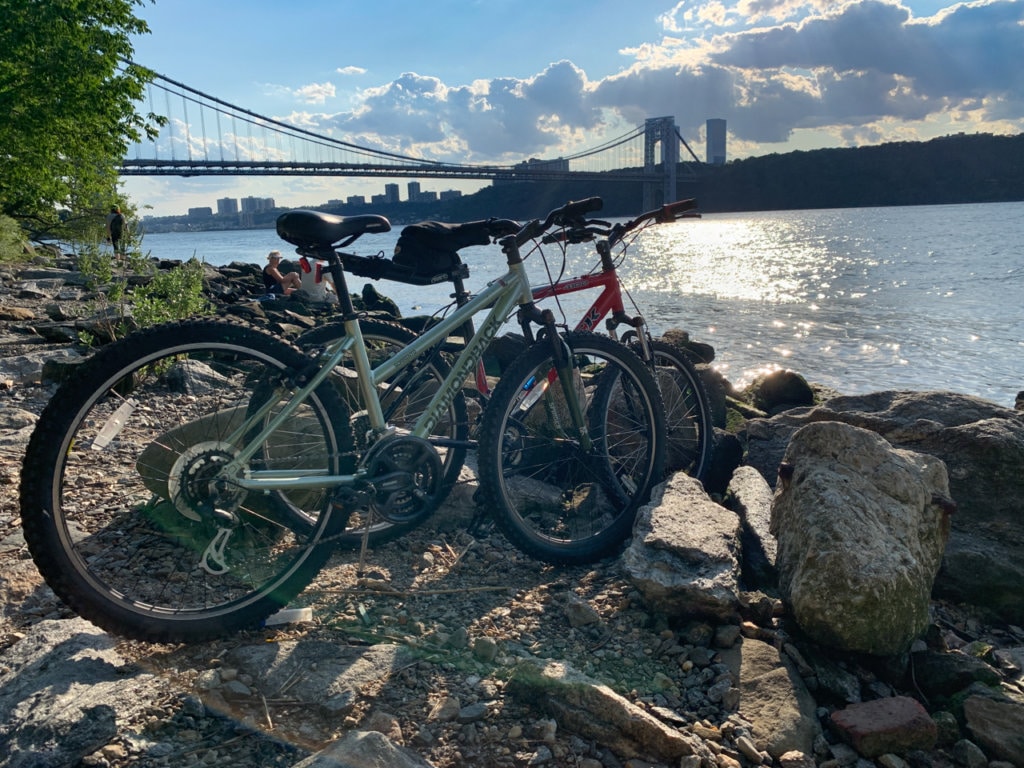
Is it possible to connect with Mother Nature in a city composed of concrete and steel? In this particular city, it absolutely is. Do you want to get the most out of nature in New York City?
Then suit up in your most comfortable, sportiest outdoor gear and take the subway to Inwood, Manhattan’s neighborhood at the most northern tip of the island. Here, it’s possible to spend an entire weekend in the great outdoors, doing activities that you may not typically think you could do in a metropolis of 8 million people.
A subway ride to the last stop on the A train offers a unique perspective of the city, away from the flashy lights of Times Square and the crowds that descend upon the most popular tourist attractions.
It’s possible to go hiking in Inwood Hill Park, kayaking on the Hudson River, bike riding to a quaint little red lighthouse, and more. In Inwood, you can commune with nature within walking distance from a subway station. Best of all, Inwood is off the beaten tourist trail, if you’re looking for non-touristy things to do in New York.
While this article focuses on outdoor recreation in Inwood, there are plenty of things to do here beyond that. If you’re interested in tourist attractions and special events, read my post, The Best Things to do in Inwood, NYC.
Read on about the outdoor activities in our Upper Manhattan neighborhood, activities that will leave you refreshed and reconnected with nature in NYC, without ever having left the city. If these activities also leave you hungry, be sure to check out Inwood’s fabulous restaurant scene.
Hike in Inwood Hill Park

In many ways, a day in Inwood Hill Park resembles a day in any other New York City park. Whenever there’s nice weather, people filter in and out, carrying blankets or foldable chairs, and maybe an afternoon’s worth of snacks or a picnic lunch. Kids expend their pent-up energy playing catch or tag and groups of friends and families sit in tight circles of conversation or nap under a shady tree.
What distinguishes this park from others, however, is that it provides a unique opportunity for hiking along trails that may cause you to forget for a moment that you’re in the most populated city in the United States.
Hiking in Inwood Hill Park is, in my opinion, the best way to take in and appreciate nature in New York City.
Inwood Hill Park contains the last natural forest in Manhattan. The landscape is maintained but not manicured, making it appear less pristine and more rustic than other city parks.
Once up in the foliage-dense hills, you may hear nothing but the high-pitched chirp of a yellow warbler or the drumming of a woodpecker echoing from a distance. And while the drone of traffic coming from the Henry Hudson Parkway is never far away, you should manage to find pockets of silence, if only intermittent ones.
One reason Matt and I decided to move to Inwood was the availability of so much open green space. We never dreamed how much we’d come to relay on it years later, when the COVID-19 pandemic shut down all of New York. In fact, we spent so much time hiking in Inwood Hill Park in 2020-2021 that we decided to make a video of our unexpected adventures in Inwood. Check it out!
Three designated Inwood Hill Park trails offer varying levels of difficulty.
- the White Trail is easy. It follows a paved path and could probably be managed in a sturdy pair of sandals.
- the Orange Trail is ranked as moderate-vigorous.
- the Blue Trail is moderate and involves steeper climbs.
- the Orange and Blue Trails would best be tackled in sneakers or boots.
Along the Inwood hiking trails, look for the following points of interest, many of which reveal centuries of Inwood Hill Park history:

Shorakkapoch Rock: If you pick up the trails at the northern bend of the soccer field, you’ll see a boulder that, as one story tells it, marks the spot where Peter Minuit purchased the island of Manhattan from the indigenous Lenape people. This remains purely speculation, however, because there is no concrete proof that this occurred here.
The rock is marked with a plaque so you’ll know it when you see it.
Overlook Meadow: For views across the Hudson River to the Palisades, follow the Orange or Blue Trail to Overlook Meadow. A little further along, look for a sign that indicates the Straus Mansion Site.
Isador Straus co-owned Macy’s department store and was one of the many Gilded Age New Yorkers who owned a country estate in what is now Inwood Hill Park. Straus and his wife Ida died on the Titanic.
Inwood Hill Park caves: You may also encounter cave-like rock formations and smooth glacial potholes (as seen in our video above!), both of which were created 50,000 years ago by the Wisconsin glacier.
Because the rock formations were formed by massive sheets of departing schist, they resemble caves and were likely used for shelter by the Lenape.

Muscota Marsh: On your way into or out of the park, make a point to check out Muscota Marsh on Spuyten Duyvil Creek.
Located at 218th Street and Indian Road, this Harlem River inlet is the convergence of a salt marsh and freshwater wetlands, creating an ecosystem that draws wildlife like blue herons, great egrets, and even a harbor seal, although it’s been a while since “Sealy” has made an appearance.
Use this interactive Inwood Hill Park trail map to find the attractions throughout the park.

Before moving here, I certainly never imagined that I’d find so many opportunities to get acquainted with nature in NYC. But I guess the reason I wanted to live here in the first place is that the city is full of the unpredictable.
Join a Guided Nature Walk in Inwood Hill Park

To learn more about the park and the creatures that reside there, I recommend checking out Friends of Inwood Hill Park, which hosts nature walks, clean-up events, birdwatching outings, and more.
As part of an Earth Day Festival, I joined a guided nature walk led by entomologist and naturalist Rachael Joakim. Rachael took us on paths that were entirely new to me, pointing out edible plants, overturning logs and describing the insects that dwell beneath them, and showing us the spots where butterflies like to hang out.
The guided walk was a perfect example of exploring my own back yard with a whole new perspective and I highly recommend it.
Each participant was also given a hard copy of “Peterson’s First Guide to Insects of North America” to help us identify insects on our own.
How to get to Inwood Hill Park

- Take the A train to 207th Street. Enter the park at 207th and Isham Street.
- Take the A train to Dyckman Street. Enter the park at Dyckman and Payson Avenue.
- Take the 1 train to 215th Street. Enter the park at 218th Street and Indian Road.
Take a Break in Isham Park

With the profusion of green space available in Inwood, Isham Park is likely not a destination in itself, especially when, just across the street lies the ten times larger green space of Inwood Hill Park.
But Isham Park, spread across a rocky hilltop at the northern end of Inwood, does offer a pleasurable shortcut through the neighborhood, allowing a brief but calm refuge from the chaotic city streets.

Isham Park is adjacent to Inwood’s weekly Farmer’s Market, which occurs every Saturday on Isham Road.
The park is named after William Bradley Isham, a merchant who purchased an estate on the land in 1864. His daughter, Julia Isham Taylor, later donated the land to the city in his memory. A massive Gingko biloba tree at the southeast corner of the park is believed to have been planted by Isham (the father).

If you find yourself in Isham Park, do make a point of checking out Bruce Reynolds Garden, a a tranquil space dedicated to a Port Authority Police Officer who grew up in Inwood and who died in the 9/11 terrorist attacks.
Spend the Day Exploring Fort Tryon Park

If you’ve been to The Met Cloisters, then you’ve been inside Fort Tryon Park. If you’ve only visited the museum without exploring this 67-acre park more thoroughly, then you’re missing out, not only on amazing New York City views, but also on an idyllic urban sanctuary, and yet another place to get the most out of nature in NYC.
Like this post? Pin it and save for future reference!


One way to explore the park is to set out with no particular goal in mind, meandering down a path one way and then up a flight of stone steps in another direction.
Fort Tryon contains eight miles of interconnected pedestrian paths. The landscape is made up of inviting green lawns, steep rocky slopes, and stone terraces with views of Inwood and the Bronx, and across the Hudson River to the Palisades.

Now, while winter in New York City can be a magical time for many reasons, spring is when nature is at its most vibrant. To witness this in Fort Tryon Park, make sure to stroll through the Heather Garden. Fort Tryon Park is fortunate to be home to this beautiful public garden, where hundreds of varieties of plants and flowers bloom throughout the seasons.
If you like gardens, you might also want to check out the Alpine Garden, which incorporates the park’s natural rocky outcropping into its landscaping. Birdwatchers should head for Cabrini Woods.

Other amenities in the park include two playgrounds, volleyball courts, built-in ping pong tables, and the biggest dog run in Manhattan.
You may also come upon the structural remains of the Billings Mansion, which was built in 1903 for wealthy industrialist Cornelius K.G. Billings. The estate included a casino, bowling alley, and swimming pool, but Billings and his family lived there for only 14 years.

In 1917, Billings sold the mansion to John D. Rockefeller, who wished to transform the land into a park. By the time Rockefeller was able to put his plan into action, the mansion was mostly destroyed in a fire.
Rockefeller hired the Olmsted Brothers, a landscape architectural company started by the sons of Frederick Law Olmsted, co-designer of Central Park. In their landscape design, they kept the remaining structures of the Billings Mansion–the most impressive being the stone arcade walkway–and incorporated them into the design of the park.
In 1935, Rockefeller, who also purchased the land across the river, gave the park to the city as a gift. 2020 was Fort Tryon Park’s 85th anniversary year.
Fort Tryon Park Events

The calendar of events in Fort Tryon Park are fully focused on helping visitors appreciate nature in NYC as well as art and culture. Events include drawing and poetry workshops, afternoon music festivals and concerts, dance lessons, movie nights, and Forest Fitness classes.
There are also group walks, guided tours, and special events for kids.
Fort Tryon Park is also the site of a popular annual Medieval Festival.
NOTE: New Leaf Café used to be a pleasant lunch spot located inside the park. They closed in January 2020 and have yet to be replaced.
How to Get to Fort Tryon Park
- There are several options for getting to the park by subway, bus, and car.
- Download this Fort Tryon Park map for more on parking, restrooms, and other amenities.
Go Kayaking on the Hudson River at Inwood Canoe Club

Inwood offers the perfect opportunity for kayaking in New York City in the summer.
From Memorial Day through Labor Day, Inwood Canoe Club hosts Open House Sundays, during which time anyone can join a guided 25-minute kayaking tour of the Hudson River.
Tours are free and previous experience isn’t necessary.
An army of volunteers are on hand, both in the water and on land, to not only instruct you on how to hold a paddle correctly and avoid tipping over, but also to remind you that the power of rowing depends on the strength of your core. They’ll also give you tips on how to handle the strong river currents that are typical when kayaking the Hudson River.
To gain regular access to the Inwood Canoe Club, one must apply, put in some volunteer hours, and then be invited to join, however Open House Sundays are free and open to the public.

Sunday kayaking tours operate from 10 a.m. – 12:00 p.m. Arriving early is recommended. The kayaks are available on a first-come, first-served basis. If you arrive early and the boats are out, you can wait in line until they return.
If you do have to wait, rest assured it’s well worth it, especially once you’re paddling down the river on a hot summer Sunday, as a breeze rises up from the river and the George Washington Bridge shimmers in the haze, a view that mitigates the tangy fish smell of the murky waters.
Hudson River kayaking is one of the best ways to enjoy summer in the city and easily my favorite way to get out in nature in New York City. Kayaking in Inwood is special because of the spectacular views from this part of the river.
Inwood Canoe Club is the oldest canoe club in Manhattan. It was founded in 1902 and, like anything that’s been around since the days of old New York, has remade itself again and again.
The boathouse, which is almost two miles north of the George Washington Bridge, burned down and was rebuilt twice. From 1956-1984, seven canoe club members competed in the Olympic Games. After the second fire in 1988, the club encouraged more recreational boating.
How to get to Inwood Canoe Club
Take the A or 1 train to Dyckman Street and walk west toward the Hudson River. See here for further directions.
Bike to the Last Remaining Lighthouse in Manhattan

The very last lighthouse in Manhattan, fondly nicknamed the Little Red Lighthouse, is a short bike-ride away from Inwood. Entering the Hudson River Greenway near Dyckman Marina, cyclists can take the Hudson River Greenway to the lighthouse.
Note that there’s a trail closer to the river, which leads to the Inwood Canoe Club—this is a dead-end foot path so be sure to look for the sign that indicates the Greenway entrance.
Ride your bike, or rent one from the nearby CitiBike docking station—down the river path until you reach the George Washington Bridge where, tucked into the bridge’s mighty base you’ll find the last remaining Manhattan lighthouse.

Originally built in 1880, the lighthouse was moved to its current location in 1921 to warn passing boats to steer clear of this dangerous rocky point, formerly known as Jeffrey’s Hook.
When the George Washington Bridge was completed in 1931, it’s bright lights dwarfed the lighthouse and rendered it unnecessary.

However, because of a 1942 children’s book “The Little Red Lighthouse and the Great Gray Bridge” by Hildegard Swift Lyndward, it had reached something of a local celebrity status. When the Coast Guard decommissioned the lighthouse and planned to destroy it, the community rallied to save it.
As a result, it was moved into the hands of NYC Department of Parks and Recreation and became part of the Historic House Trust of New York City.

The bike ride from Dyckman Marina to the Little Red Lighthouse is a two-mile ride. The paved path is bumpy in some areas—those bumps are usually marked by orange spray paint or traffic cones—but always ride with caution.
Walking on the Hudson River Greenway is also permitted but note that the path runs parallel to the busy Henry Hudson Parkway for a lot of the way. The path is protected from traffic but can be noisy if you’re looking for a quiet stroll.
Just before reaching the lighthouse, the path goes steeply downhill, away from the highway and along the river for a quieter ride away from traffic.

For those who wish to continue on past the lighthouse, the Hudson River Greenway runs the entire length of Manhattan.
If you don’t want to walk or ride a bicycle, the Little Red Lighthouse is accessible by public transportation. Take the A or 1 train to 181st Street and walk west toward the George Washington Bridge.

Click to see an interactive version of the above map!
Like this post? Pin it and save for future reference!


Thanks much for covering our summer Sunday Open House kayaking program. Looking forward to our 2020 program which will start on Memorial Day weekend.
We loved the Sunday Open House kayaking and can’t wait until next year! Thanks for commenting!